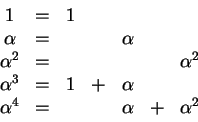Problem
O-1. For the field
![]() , it is a fact that there is a generator
, it is a fact that there is a generator
![]() that is a root of the irreducible polynomial
that is a root of the irreducible polynomial
![]() ,
so
,
so
![]() . Also, since
. Also, since ![]() is a generator of
the seven nonzero elements, we know
is a generator of
the seven nonzero elements, we know
![]() .
.
(a) Make a table showing how to write each
power of ![]() as a linear combination of the basis
as a linear combination of the basis
![]() .
In the table, use blank spaces to indicate 0 coefficients. The table will start
.
In the table, use blank spaces to indicate 0 coefficients. The table will start

From there on, multiply through by ![]() and simplify using what we
know about
and simplify using what we
know about ![]() .
.
It is handy to use the powers of ![]() when multiplying and
the linear combinations when adding.
when multiplying and
the linear combinations when adding.
(b) Find
![]() as a linear combination of
as a linear combination of
![]() by using the table.
by using the table.
(c) Find
![]() as a power of
as a power of ![]() by using the table.
by using the table.
Problem
O-2. (a) For ![]() in
in
![]() , show that
, show that
![]() .
.
(Method: Like Fermat and Euler.)
(b) Show that
![]() for any
for any ![]() in
in
![]() .
.
(Method: Start with (a) and multiply through by ![]() .)
.)
(c) Let
![]() be given by
be given by
![]() .
Show that
.
Show that ![]() , meaning
, meaning
![]()
![]() times,
equals
times,
equals ![]() for every
for every ![]() in the field.
in the field.
Problem
O-3. Show that in a finite field ![]() of characteristic
of characteristic ![]() , the map
, the map
![]() given by
given by
![]() is an automorphism--an
isomorphism of the field with itself. You will need to show
is an automorphism--an
isomorphism of the field with itself. You will need to show
(i)
![]()
(ii)
![]() . (What do you know about
binomial coefficients?)
. (What do you know about
binomial coefficients?)
(iii) ![]() is one-to-one from
is one-to-one from ![]() onto
onto ![]() .
.
(Method for (iii): You may quote (c) of the preceding problem, whether or
not the problem was assigned. If ![]() is not one-to-one, could
a composition of
is not one-to-one, could
a composition of ![]() with itself be one-to-one? Similary for onto?)
with itself be one-to-one? Similary for onto?)
Problem
O-4. (a) Show that if a unit ![]() in
in
![]() has order
has order ![]() and
and
![]() then
then ![]() has order
has order ![]() .
.
(b) Show that if ![]() and
and ![]() are positive integers and
are positive integers and
![]() lcm
lcm![]() then there are divisors
then there are divisors ![]() and
and ![]() of
of ![]() and
and ![]() respectively
such that
respectively
such that
![]() and
and ![]() and
and ![]() are coprime.
are coprime.
(Method: Use prime factorizations.)
(c) Prove (g)-(ii) on p. H 2: If a commutative ring ![]() has a unit
has a unit
![]() of order
of order ![]() and a unit
and a unit ![]() of order
of order ![]() , then
, then ![]() has a
unit of order
has a
unit of order ![]() where2
where2
![]() lcm
lcm![]() . (Note that
this element is not necessarily
. (Note that
this element is not necessarily ![]() , since for example
if
, since for example
if
![]() then
then ![]() and
and ![]() have the same order
have the same order ![]() and
lcm
and
lcm![]() , but
, but ![]() , which is an element of order 1.)
, which is an element of order 1.)
(Method: Use (a) and (b) and N-3.)
(d) Show that in
![]() if the maximum order of a unit is
if the maximum order of a unit is ![]() then the order of every unit actually divides
then the order of every unit actually divides ![]() .
.
Then by (a), the possible orders of units are ![]() and all its
divisors.
and all its
divisors.
(Method: If ![]() has the maximum possible order,
has the maximum possible order, ![]() , and another
unit
, and another
unit ![]() has order
has order ![]() , what about
lcm
, what about
lcm![]() ?)
?)
Problem O-5. Prove that a finite field has a generator for the nonzero elements.
(Method: You may quote (d) of the preceding problem, whether or not
it was assigned. If the maximum order of an element is ![]() , show
that
, show
that ![]() for every nonzero element
for every nonzero element ![]() . In that case,
every nonzero element is a root of
. In that case,
every nonzero element is a root of ![]() . You know how to
compare the number of roots and the order. So how large must
. You know how to
compare the number of roots and the order. So how large must ![]() be?
And remember, there is an element of order
be?
And remember, there is an element of order ![]() .)
.)